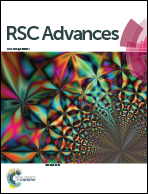Influence of electronic vs. steric factors on the solid-state photochromic performances of new polyoxometalate/spirooxazine and spiropyran hybrid materials†
Abstract
Two new photochromic hybrid organic–inorganic supramolecular materials (SN)2[W6O19] (SN2W6) and (SP)2[W6O19]·0.5CH3CN (SP2W6) have been elaborated by combining for the very first time an isopolyoxotungstate [W6O19]2− with both photoswitchable cationic spirooxazine (SN) and spiropyran (SP), via electrostatic interactions. (SN)2[Mo6O19] (SN2Mo6), a third new photochromic compound which contains the [Mo6O19]2− unit, has been also designed. Their structure was solved by single-crystal X-ray diffraction analysis, and their solid-state photochromic properties in ambient conditions were thoroughly investigated by UV-visible diffuse reflectance spectroscopy. SN2W6 and SN2Mo6 have been proved to be isostructural while SP2W6 is isostructural with its already reported counterpart SP2Mo6. In the SN2M6 and SP2M6 series, the SN and SP molecules are in very close contact with the POM units, which a priori should dramatically limit their photoisomerization in the solid state. However, this strongly varies with the nature of the metal in the [M6O19]2− unit. Indeed SN2W6 and SP2W6 exhibit remarkable photochromism under low-power UV excitation (λex = 365 nm) while SN2Mo6 and SP2Mo6 develop very limited color-change effects under similar UV exposure. These results have unambiguously highlighted that the efficiency of the SN and SP photoisomerizations in these hybrid systems is much more impacted by an electronic factor resulting from the intrinsic optical absorption properties of both SP and POM components than by a steric factor induced by crystal packing.


 Please wait while we load your content...
Please wait while we load your content...